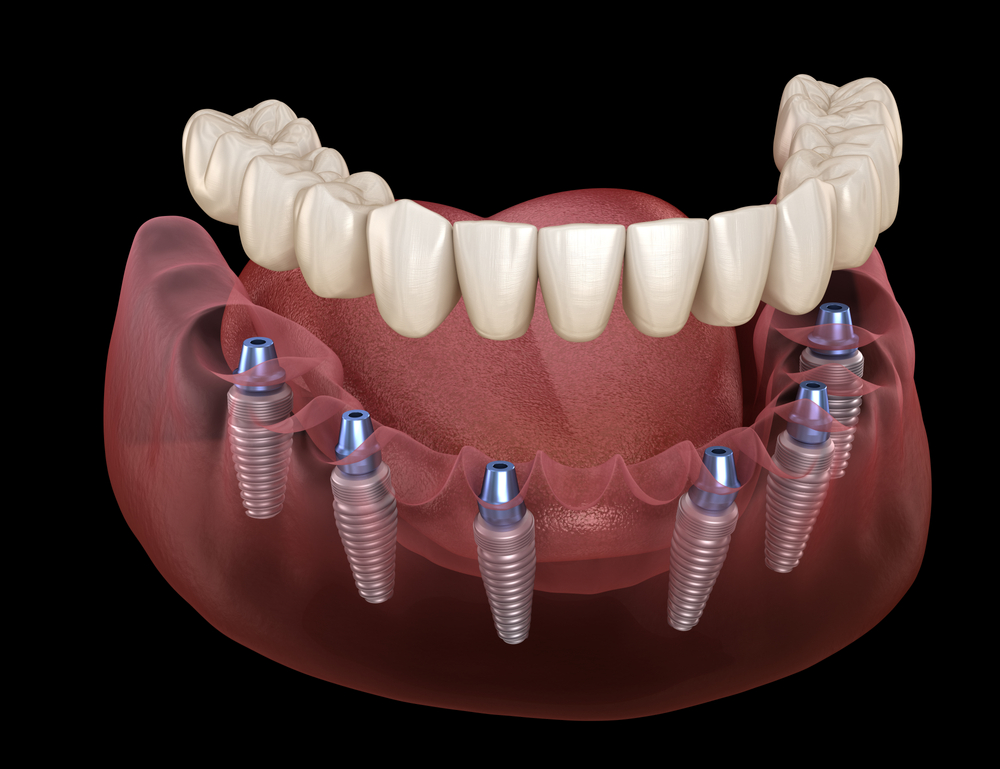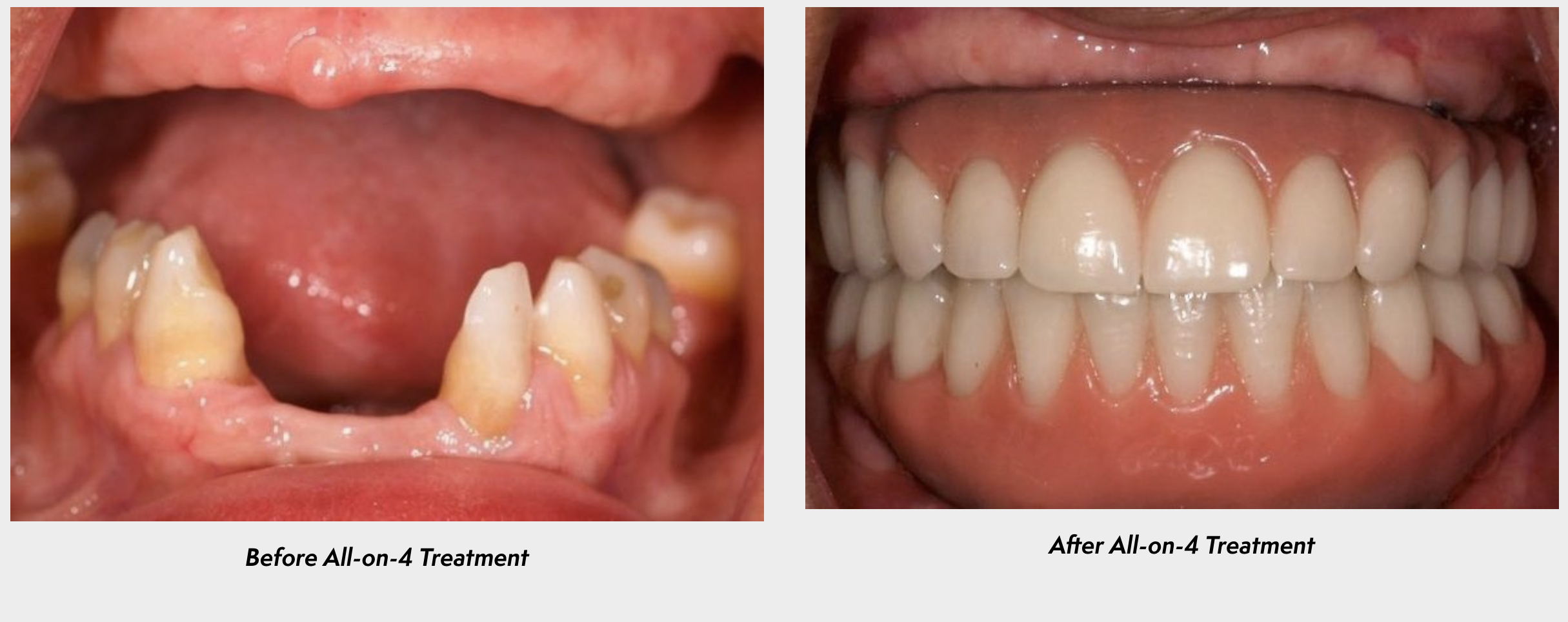Traditional Dental Implants vs. All-on-4: Which Is Right for Me?

Missing most or all of your teeth can make chewing and speaking difficult. Dental implants are an amazing restorative dentistry procedure that is paired with crowns, bridges, and dentures to replace missing teeth. At 38th Street Dental in Austin, TX, we provide both traditional dental implants and All-on-4® dental implants to help more patients than ever enjoy beautifully restored smiles and superior stability for their dentures. Learn about the differences and which type of dental implant may be right for you.
What Are Dental Implants?
Dental implants are artificial tooth roots, often made of titanium. After I place an abutment or connected piece, a restoration such as a dental crown, dental bridge, or denture can be attached.
Superior Stability
Dental implants provide superior stability to your restorations. No denture adhesive is required for implant-supported dentures, so there is no risk of slippage when you eat or speak. You can expect your dentures to look, feel, and function just like natural teeth. With proper care, implants can last for decades.
Better Bone Health
Dental implants also provide the jawbone with much-needed stimulation to remain healthy. Once you lose a tooth, the jaw no longer receives the stimulation it once did from the tooth roots. This often results in jawbone deterioration which can lead to further tooth loss and a sunken facial appearance. Dental implants can stop and prevent this bone loss from occurring, keeping your jaw healthy and strong.
What Is the All-on-4 Method?

Some patients come to our dental practice with existing bone atrophy. However, traditional dental implants require a certain amount and density of bone to be present. This used to mean that patients with bone deterioration had to undergo bone grafting before they qualified for dental implants.
With the All-on-4 method, we can often treat these patients without the need for preparatory bone grafting. Like traditional implant dentures, the procedure is recommended for patients missing all of their teeth along an arch.
Unlike traditional dental implant surgery, which often requires six to eight posts, All-on-4 requires just four strategically placed implants for each dental arch.
Once the implants fuse to the bone in a process called osseointegration, I can secure your custom dentures to the implants, giving you superior stability and a restored smile.
All-on-4 and Traditional Implants: Important Differences to Consider
There are a few key differences between these types of dental implants, including:
- The number of implants used - Depending on your degree of tooth loss, one to eight implants are used. Patients missing all of their natural teeth often require six to eight implants using the traditional method of implant placement. As its name implies, All-on-4 uses just four for a full-arch denture.
- Immediate denture placement - With traditional implants, most patients require a healing period before their dentures can be secured to the implants. With the All-on-4 method, a temporary set of dentures can often be attached immediately after implant placement surgery. However, it should be noted that some patients do find their temporary dentures are not as comfortable as their permanent restorations.
- Recovery time - Because the All-on-4 method requires fewer implants, recovery time is typically shorter than traditional dental implants. It is also less invasive than traditional implants, especially if you would otherwise require bone grafting. The major benefit to All-on-4 is that even patients with some degree of bone loss can qualify.
- Area covered - The placement of All-on-4 implants will not target the molar area, which can mean that the back area of the dental arch could further deteriorate.
Are Traditional Implants or All-on-4 Implants Best for Me?
During your initial consultation at 38th Street Dental in Austin, TX, I will examine your mouth and discuss your concerns and goals to determine the best course of treatment. You may be a candidate for All-on-4 dental implants if you:
- Have some amount of jawbone loss - The All-on-4 method is a great option for patients with some degree of jawbone recession as it utilizes the existing bone material. During the procedure, your dentist will place the two posterior implants at a 45-degree angle, maximizing contact with the bone. Depending on your needs, you may require more than four implants, which would make traditional implants or other methods of implant placement a better option for you.
- Have widespread tooth loss - The All-on-4 method is used for patients who have widespread tooth loss, meaning you are missing most or all of your natural teeth. If you are only missing a small number of teeth, traditional implants paired with a custom dental crown or dental bridge may be the best option for you.
- Have good oral health - No matter which method of dental implants you and your dentist decide is best for you, you must be in good oral health. This means you must be free of gum disease and tooth decay before you qualify for implant placement. Preparatory procedures such as periodontal treatment or tooth extraction may be needed before implant placement.
- Are in good overall health - To minimize the risk of complications, you should be fairly healthy before undergoing implant placement. Patients with existing issues such as diabetes need to have their glucose levels under control. You are also encouraged to quit smoking or chewing tobacco if you do because the habit can lead to implant failure. If you have any health conditions or take medications, it is important to inform me or my team so we can ensure your health and safety during treatment.

What If I Have Significant Bone Loss?
Even All-on-4 dental implants require a certain amount of existing bone material. Without that bone, the implants would not have a stable foundation and could fail, or fail to fuse with the bone. I strive to recommend and provide the least invasive treatment possible, but I also want my patients to have the best chance at success so they can enjoy a beautiful and functional smile for years to come.
While All-on-4 dental implants often eliminate the need for bone grafting, for patients with significant bone loss, bone grafting may still be recommended. This will ensure a solid foundation for further restorative treatment. However, after you are healed from bone grafting, dental implants can be placed to prevent further bone loss and keep your jaw healthy for years to come.
Still Not Sure Which Is Right for You?
Call 38th Street Dental Today!
No matter which type of implant you need, the sooner you see a dentist and get the process started, the better. Request a dental implant consultation at our Austin, TX, dental practice by contacting us online or by calling us. We look forward to helping you on your smile restoration journey.
 About C. Mike Meek, DDS
About C. Mike Meek, DDS
Dr. Mike Meek is a dental implant authority who lectures nationally for Nobel Biocare on the subject. He has a Fellowship with the Academy of General Dentistry.
Read Dr. Meek's Full Bio | All Posts by Dr. Mike Meek


